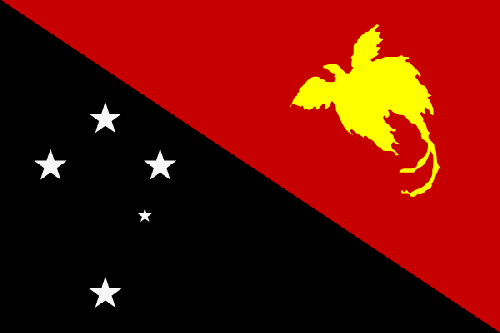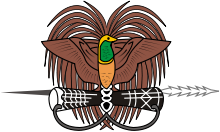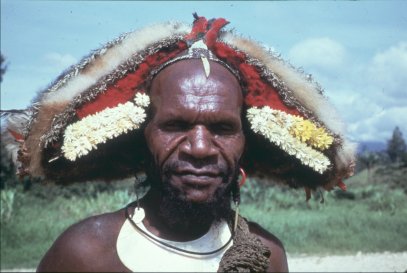

 |
 |
|
Papua New Guinea (PNG) is one one half of the island of New Guinea. The boundary is totally artificial, representing colonial ambitions in the area. The eastern half of the island was colonized by the Dutch as Dutch New Guinea. Following the withdrawal of the Dutch from the area, that part of the island became part of Indonesia as Irian Jaya. From 1884, the north-east part of New Guinea was ruled by Germany as German New Guinea and the sounth-east part was taken by Britain as British New Guinea. Hence the Germanic names of Mount Wilhelm (the country’s highest peak) and the Bismark Sea. In 1905 British New Guinea was transferred to Australian administration as Papua. After World War I German New Guinea was ruled by Australia under a United Nations mandate, so that both territories were administered separately by the same country. Only after World War II were the two territories combined into Papua New Guinea, which became independent in 1975.
 The island of New Guinea in relation to the Melanesian Cultural Area |
 Territorial extent of the nation state of Papua New Guinea (since 1975) |

Archaeological research suggests that this island was first inhabited 45-42,000 years ago, and independently developed agriculture about 7,000 years ago. The people are Melanesian, a distinct ethnic group whose approximate boundaries are shown in the map above. Around 500BC a second wave of immigration occurred, introducing both the making of pottery and the domestic pig, which became an important part of PNG culture.
Duna wigman from the Southern Highlands. Image courtesy of Atea 78 Speleological Expedition to PNG.
Melanesian peoples normally practice male circumcision, typically by a simple dorsal slit, like the Polynesians. However, in the very fragmented tribal nature of traditional PNG society, practices vary widely in different regions. Maclaren et al. 2013, summarized the current situation:
| Style name | Style description | Frequency |
|---|---|---|
| Uncircumcised | Natural foreskin unmodified | 43% |
| Longitudinal cut | Any form of longitudinal incision of the prepuce that exposes the glans but does not remove the prepuce |
47% |
| Circumferential cut | Full removal of the prepuce with full exposure of the glans | 10% |
| 88% of participants originated from the principal land mass of New Guinea, 12% from outlying islands | ||
PNG is now a country with a high prevalence of HIV, through no fault of its own, and given the known value of circumcision in hindering the spread of HIV, the question has arisen as to whether traditional dorsal slit cuts are as effective as full circumcision. This waspart of the focus of the cited Maclaren et al. paper but was also the subject of a seminar at Cairns Base Hospital organized by James Cook University, and a report of this is given below.
22 September 2011 : Seminar regarding circumcision in PNG held at Cairns Base Hospital
Researchers investigating male circumcision as a possible way to reduce HIV transmission in the diverse cultural surroundings of Papua New Guinea presented their work at a seminar and discussion panel at Cairns Base Hospital, Queensland, Australia, on Thursday 22 September 2011 as part of James Cook University’s Celebrating Research@JCU series.
“Papua New Guinea has more than ninety per cent of all the cases of HIV in Oceania”, Professor McBride said in a press release advertising the gathering. “This disease is having a major impact on our nearest neighbour’s social, economic, educational, and cultural development.
“This is also a critical issue for our region. PNG is only an hour and a half flight from Cairns and just four kilometres from Saibai Island.”
Dr MacLaren said male circumcision might be an additional way to reduce HIV transmission, but there was little information on current circumcision practices or whether this would be an acceptable approach in PNG. “We have been working in partnership with Pacific Adventist University and Divine Word University in PNG to explore whether increasing the number of men who are circumcised would be an acceptable and feasible way to reduce HIV transmission”, he said.
The researchers talked with over 860 men in four locations and found that only about 10% of men were circumcised in the true sense, but that a further 47% had less complete forms of circumcision where the foreskin had been cut but not removed. “One of the issues that emerged is that the majority of men we spoke to had the procedure outside any health facility, most often done by friends or relatives”, Dr MacLaren said. “Many of the procedures differ from a classic circumcision and we now need to investigate whether these types of cuts help reduce HIV transmission.”
The researchers have also interviewed 510 women on whether male circumcision was a good thing for their partners and their children. Some were happy with the health benefits of male circumcision while some worried that men might feel less at risk of HIV and so be less likely to practise safe sex.
The research was presented at a well-illustrated seminar and panel discussion at Cairns Base Hospital on Thursday, 22 September 2011.
Reference
MacLaren D, Tommbe R, Mafile'o T, et al. Foreskin cutting beliefs and practices and the acceptability of male circumcision for HIV prevention in Papua New Guinea. BMC Public Health. 2013;13(818):1-17.
Acknowledgements
The following resources were used in the preparation of this web page:
Wikipedia
Roberts, A. The Incredible Human Journey, 2009. London:Bloomsbury. pp 90-91 and the associated BBC-TV series.
Seminar presentation “Cutting Edge Research: Investigating Male Circumcision for HIV Prevention in Papua New Guinea”, James Cook University, Cairns, Australia.
Maps courtesy of Wikipedia and the US Central Intelligence Agency.